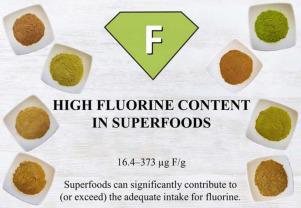Journal of Fluorine Chemistry ( IF 1.7 ) Pub Date : 2020-04-07 , DOI: 10.1016/j.jfluchem.2020.109521 Dona Štepec , Gašper Tavčar , Maja Ponikvar-Svet

|
Recent years have seen soaring interest in exotic superfoods, which are believed to have extraordinary health benefits. The purpose of the study was to broaden the current knowledge on exotic superfoods and to analyse them for fluorine1 since excessive intake during prolonged periods of time can cause adverse effects. The fluorine content was determined in 18 plant-based exotic superfoods available on Slovenian market by fluoride ion selective electrode after prior total decomposition with alkaline carbonate fusion. In 8 of the analysed samples, the F content was surprisingly high in comparison to F content in commonly consumed foods (< 3 µg/g). The highest F content was found in matcha (373 µg/g), followed by gotu kola (111 µg/g) and gingko biloba (91.0 µg/g). The F content in tulsi, neem, brahmi, gynostemma and moringa was lower and ranged between 16.4–68.8 µg/g. Despite high F content, these superfoods do not pose a risk to human health in non-fluoridated water areas, because they are usually consumed in low quantities. However, in fluoridated water areas (e.g. some parts of Ireland, United Kingdom, United States, Canada) or in areas with high natural fluoride concentration in drinking water, superfoods should be consumed with caution, since the intake of F can with simultaneous consumption of superfoods and tea on a normal diet easily exceed the adequate intake or even reach the upper limit for fluorine. The F content in these 8 superfoods was also surprisingly high in comparison to the usual F content in most plant species (< 10 µg/g). The high F content in matcha is understandable since it is made of Camellia sinensis L. leaves, but the high F content in other superfoods is worrisome because the reason for such high F content is unknown and it is possible that these superfoods are contaminated with fluoride due to industrial or agricultural activities.
中文翻译:

某些外来超食物中的氟含量惊人地高
近年来,人们对异国超级食品的兴趣激增,据信这些超级食品具有非凡的健康益处。这项研究的目的是拓宽有关外来超级食品的现有知识,并分析它们中的氟1。因为长时间摄入过多会造成不利影响。在事先与碱式碳酸盐熔融物完全分解后,通过氟离子选择电极在斯洛文尼亚市场上可买到的18种植物基外来超级食品中测定氟含量。与常规食用食品中的F含量(<3 µg / g)相比,在8个分析样品中F含量高得令人惊讶。抹茶中的最高F含量(373 µg / g),其次是葛图可乐(111 µg / g)和银杏(91.0 µg / g)。图尔西,印em,婆罗米,绞股蓝和辣木中的F含量较低,范围在16.4–68.8 µg / g之间。尽管F含量高,但这些超级食品在非氟化水区域中不会对人类健康构成威胁,因为它们通常被少量摄入。但是,在氟化水区域(例如 爱尔兰,英国,美国,加拿大的某些地区)或饮用水中天然氟化物浓度较高的地区,应谨慎食用超级食品,因为摄入F可以同时在正常饮食中同时食用超级食品和茶超过足够的摄入量,甚至达到氟的上限。与大多数植物中通常的F含量(<10 µg / g)相比,这8种超级食品中的F含量也令人惊讶地高。抹茶中的高F含量是可以理解的,因为它是由 因为正常饮食中同时摄入超级食品和茶可以摄入F,很容易超过适当的摄入量,甚至达到氟的上限。与大多数植物中通常的F含量(<10 µg / g)相比,这8种超级食品中的F含量也令人惊讶地高。抹茶中的高F含量是可以理解的,因为它是由 因为正常饮食中同时摄入超级食品和茶可以摄入F,很容易超过适当的摄入量,甚至达到氟的上限。与大多数植物中通常的F含量(<10 µg / g)相比,这8种超级食品中的F含量也令人惊讶地高。抹茶中的高F含量是可以理解的,因为它是由茶花叶,但是其他超级食品中的高F含量令人担忧,因为尚不清楚如此高F含量的原因,并且这些超级食品可能因工业或农业活动而被氟化物污染。











































 京公网安备 11010802027423号
京公网安备 11010802027423号